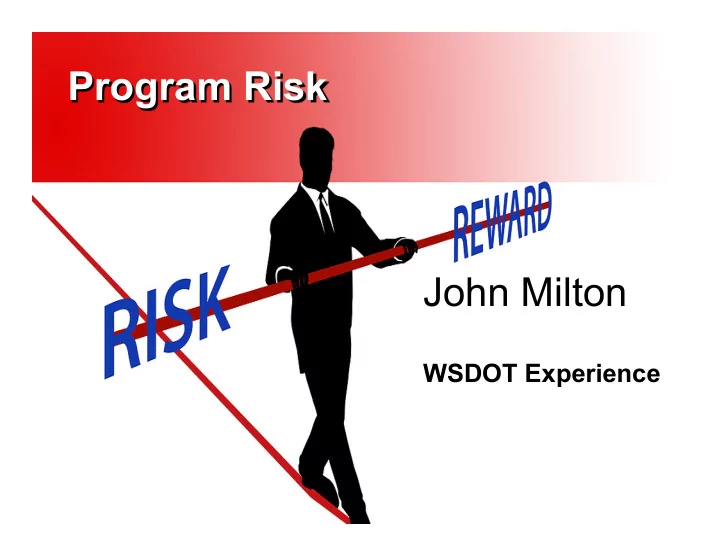

Program Risk John Milton WSDOT Experience
Risk and Performance Management Improving agency performance Lynn Peterson Risk and Asset Management Peer Exchange John Milton, Ph.D. PE Director - Quality Assurance and Secretary of Transportation August 25, 2015 Transportation System Safety Minneapolis, Minnesota Washington State Department of Transportation 2
What got us here: using safety and preservation as examples 1. HISTORIC PERSPECTIVE 3
Highway Construction Program PRESERVATION (P) Roadway (P1) Structures (P2) Other Facilities (P3) Program Support (P4) Paving Preservation Rest Areas Unstable Slopes Safety Catastrophi Weigh Stations Major Drainage & Electrical Restoration c Reduction IMPROVEMENT (I) Mobility (I1) Safety (I2) Economic Initiatives (I3) Environmental Retrofit (I4) Program Support (I5) Urban Collision All Weather Stormwater Chronic Env Reduction Deficiency 1995 2007 Rest Rural Fish Barriers Wildlife Connectivity Areas (In Safety) Collision Urban Noise Reduction Mgmt of Environmental Preventio Scenic Byways Bicycle Mitigation Sites n Air Quality Freight System Core HOV Restricted Bridges Strategy no longer active Bicycle Touring 4
Telling elling the he stor ory Funding crisis & meeting pavement preservation goals Pavement ement: : Risk: declining funding: Tar arget get lo lowes est lif life- e- § Maintaining over 20,000 lane miles while funding dropped by cycle le cos cost $600 million in 10 years (27% reduction) Mitigation strategies: Create efficiencies § Target lowest life-cycle cost – WSDOT achieves pavement condition goals amidst funding crisis *Note: Projections as of December 2011. 5
Recent Inflation Trend Construction Cost Index 10.0 2008 ¡2Q 7.5 2005 ¡2Q 5.0 Two gas tax increases at 5¢ and 9¢ per gallon and project budgets set before 2.5 increases to construction costs 0.0 1970 1975 1980 1985 1990 1995 2000 2005 2010 2015 2006 3Q 2007 2Q 2008 2Q 2005 2Q 2006 1Q 2007 4Q 6
… and compelling communication of risk is Gas Gas tax ax more important than ever pur purchas hasing ing Funding crisis po power er dec declines lines § Revenue significantly under projections over er time ime § Inflation increasing cost of maintenance and construction Gas tax Gas ax not not § Challenge in getting another tax increase indexed inde ed to o inf infla lation ion Promis omise e to o deliver deliv er on on time ime and and on on budget budget • Includes maintenance, preservation, safety improvements, and other department operations. ** Less Debt Service. 7 Source: WSDOT
Tracking cost versus pavement performance Expenditures (June 2011 Real Good/fair Pavement Preservation % of all pavements Dollars) in Millions $ Pavement Preservation Poor State highway pavement trends (1980 – 2010) All pavement types (1981 – 2010) 8
Mit itiga igating ing Ris isks ks WSDOT’s pavement technology innovations help offset declining investments Pavement ement: : WSDOT uses pavement technology to make the state’s roads last Inno nnovations ions to o lo lower er longer and cost less. Efficiencies include: cos costs, , pr pres eser erve e lif life e § Dowel bar retrofits on concrete pavements § Selective panel replacement and diamond grinding on concrete pavements § Converting higher cost asphalt pavements to lower cost chip seal pavements ($151 million saved as of December 2011) 9
Level of Service versus Life Cycle Cost (Accumulated cost / Annual cost) of not being at LLCC Life Cycle Cost ($) Level of Service 10
Net Benefit (EUAC) 5000 4000 3000 Net Benefit EUAC ($/yr) 2000 Crack Sealing Sealing & Patching 1000 Chip Seal 0 +0 +1 +2 +3 +4 +5 +6 +7 +8 +9 +10 -1000 -2000 -3000 Years Added by Preservation Treatment
Asphalt Pavement Preservation Decisions Reconstruction ($ Do Nothing $$$$$) Maintenance ($) Hold or Push Reduce Emergent Preventive Rehabilitation Need Rehabilitation ($$$) 100 Condition Indexes 0 Years
Decisions and Outcomes Rehabilitation (what, when, where, how, why) Maintenance. Reconstruction (what, when, where, (what, when, where, how, why) how, why) Performance Cost (achieve minimum (minimize LCC) requirement)
Uses for Economic Performance Methodologies • Evaluation of Pavement Management § How efficiently are pavements performing? § Are the most cost-effective decisions being implemented? • Evaluation of Pavement Design § Is pavement structure over designed or under designed? • Evaluation of Freight Corridors § Are freight corridors designed with the most efficient pavements?
1990-2010: Changes in Pavement Asset Management Then (1990) Now (2010) Worst first Lowest life cycle cost Allocation funding Need based funding WSPMS as sideline WSPMS as key decision making tool Hveem mix design protocol Superpave mix design Volumetrics in the lab Volumetrics in the field Concrete Total Replacement Dowel bar retrofit Dowel bar retrofit Triage protocol Thick overlays (>2"+) P-1 protocol (2" overlays for all HMA) No westside BST All west side regions doing BST BST only if ADT <2000 ADT BST on all routes under 5,000 ADT and consideration for routes between 5,000-10,000 No RAP Consuming all the RAP produced in the state No RAS Test project with RAS No clear pavement selection Pavement Type Selection Protocol No dowel bar selection Dowel Bar Selection Protocol
Recommend
More recommend